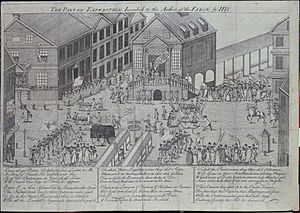Paxton Boys facts for kids
The Paxton Boys were a group of frontiersmen from central Pennsylvania. They formed a vigilante group in 1763. This group wanted to protect themselves from attacks by local American Indians. This happened after the French and Indian War and Pontiac's War.
The Paxton Boys are known for a terrible event called the Conestoga Massacre. They murdered 20 Susquehannock men, women, and children. The group formed because colonists were angry about Pontiac's rebellion. They felt the Pennsylvania government was not doing enough to protect them. The Paxton Boys were very aggressive. This was different from the pacifist beliefs of the Quakers, for which Pennsylvania was known.
After attacking the Conestoga, about 250 Paxton Boys marched towards Philadelphia in January 1764. They wanted to show their anger to the government. Leaders met them in Germantown. The Paxton Boys agreed to leave after Benjamin Franklin promised their complaints would be heard by the government.
What Happened to the Conestoga?
After the French and Indian War, new settlers from Scotland and Ireland moved into Pennsylvania's frontier. They often settled on Native American land, even though treaties said they shouldn't. These settlers claimed that Native Americans often raided their homes.
Reverend John Elder was a pastor in Paxtang. He became a leader for the settlers. People called him the "Fighting Parson." He even kept his rifle in the pulpit during his sermons. Elder helped organize the settlers into a mounted militia. He became the captain of this group, known as the "Pextony boys."
The Paxton Boys claimed the Conestoga people were secretly helping rebellious tribes. But there was no proof of this. On December 14, 1763, a group of frontiersmen attacked Conestoga homes at Conestoga Town. This is near modern-day Millersville. They murdered six people and burned their cabins. Most of the camp was destroyed.
The government investigated and said the killings were murder. The new governor, John Penn, offered a reward to catch the Paxton Boys. Governor Penn placed the remaining sixteen Conestoga people in a safe place in Lancaster. But the Paxton Boys broke in on December 27, 1763. They killed six adults and eight children.
After this second attack, the Pennsylvania government offered a new reward of $600. But the attackers were never found. Many people where the Paxton Boys lived supported them. So, no one was ever punished for the murders.
March to Philadelphia
In January 1764, the Paxton Boys marched towards Philadelphia. There were about 250 men. They wanted to challenge the government for not protecting them. Benjamin Franklin led a group of city leaders to meet them. They met in Germantown, which was a separate town then. The leaders listened to their complaints.
The Paxton Boys had written a pamphlet about their issues. After the leaders promised to read this pamphlet to the government, the group agreed to go home.
Many colonists were very upset about the killings of innocent Conestoga people. They said the murders were more brutal than any committed by Native Americans. Benjamin Franklin wrote about the events in his "Narrative of the Late Massacres." He wrote that the Conestoga would have been safe anywhere else in the world. But they were not safe from the "'white savages' from Peckstang and Donegall!"
In Books
These books mention the Paxton Boys:
- The Light in the Forest (1953), by Conrad Richter.
- Mason & Dixon (1997) by Thomas Pynchon, which includes the Lancaster Massacre.
- Robert J. Shade. Conestoga Winter: A Story of Border Vengeance (Forbes Road) (volume 2; 2013) also includes the Lancaster Massacre.
- Mindy Starns Clark and Leslie Gould. The Amish Seamstress (2013); the main character learns about Amish involvement in these events.
- Ghost River: The Fall & Rise of the Conestoga, published by the Library Company of Philadelphia.


